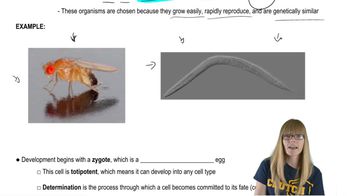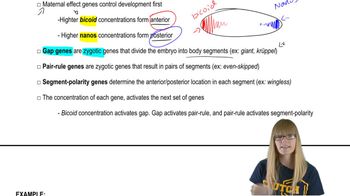Table of contents
- 1. Introduction to Genetics51m
- 2. Mendel's Laws of Inheritance3h 37m
- 3. Extensions to Mendelian Inheritance2h 41m
- 4. Genetic Mapping and Linkage2h 28m
- 5. Genetics of Bacteria and Viruses1h 21m
- 6. Chromosomal Variation1h 48m
- 7. DNA and Chromosome Structure56m
- 8. DNA Replication1h 10m
- 9. Mitosis and Meiosis1h 34m
- 10. Transcription1h 0m
- 11. Translation58m
- 12. Gene Regulation in Prokaryotes1h 19m
- 13. Gene Regulation in Eukaryotes44m
- 14. Genetic Control of Development44m
- 15. Genomes and Genomics1h 50m
- 16. Transposable Elements47m
- 17. Mutation, Repair, and Recombination1h 6m
- 18. Molecular Genetic Tools19m
- 19. Cancer Genetics29m
- 20. Quantitative Genetics1h 26m
- 21. Population Genetics50m
- 22. Evolutionary Genetics29m
14. Genetic Control of Development
Developmental Patterning Genes
Problem 17
Textbook Question
In contrast to Drosophila, some insects (e.g., centipedes) have legs on almost every segment posterior to the head. Based on your knowledge of Drosophila, propose a genetic explanation for this phenotype, and describe the expected expression patterns of genes of the Antennapedia and bithorax complexes.
 Verified step by step guidance
Verified step by step guidance1
Understand the role of Hox genes: Hox genes are a group of related genes that control the body plan of an embryo along the anterior-posterior axis. In Drosophila, the Antennapedia and bithorax complexes are subsets of Hox genes responsible for segment identity.
Analyze the Antennapedia complex: The Antennapedia complex in Drosophila specifies the identity of anterior segments, such as the head and thorax. Mutations or misexpression in these genes can lead to legs forming in inappropriate locations, such as on the head.
Examine the bithorax complex: The bithorax complex specifies the identity of posterior segments, such as the abdomen. In Drosophila, these genes suppress the development of legs in abdominal segments. A loss of function or altered regulation of these genes could result in legs forming on posterior segments.
Propose a genetic explanation for centipedes: In centipedes, the phenotype of legs on almost every segment posterior to the head could be explained by differences in the regulation or expression of Hox genes. Specifically, the bithorax complex may not suppress leg development in posterior segments, or the Antennapedia complex may promote leg development across more segments.
Describe expected expression patterns: In centipedes, the Antennapedia complex genes might be expressed in a broader range of segments, promoting leg development. The bithorax complex genes might either be absent or expressed differently, failing to suppress leg formation in posterior segments.
 Verified video answer for a similar problem:
Verified video answer for a similar problem:This video solution was recommended by our tutors as helpful for the problem above
Video duration:
3mPlay a video:
Was this helpful?
Key Concepts
Here are the essential concepts you must grasp in order to answer the question correctly.
Segmental Development in Insects
Insects exhibit a segmented body plan, where each segment can develop distinct structures. In Drosophila, segments are specified by the expression of particular genes, which determine the identity and characteristics of each segment. This segmentation is crucial for understanding how different insects, like centipedes, can have varying numbers of legs based on their segmental development.
Recommended video:
Guided course

Genetics of Development
Antennapedia Complex
The Antennapedia complex is a group of homeotic genes in Drosophila that control the development of segment identity, particularly in the thorax and head regions. Mutations in these genes can lead to the transformation of one body part into another, such as legs developing where antennae should be. Understanding this complex helps explain how variations in leg development can occur in different insect species.
Recommended video:
Guided course

Segmentation Genes
Bithorax Complex
The Bithorax complex is another set of homeotic genes that regulate the development of the posterior segments in Drosophila. It plays a critical role in determining the identity of the third thoracic segment and the abdominal segments. The expression patterns of these genes can elucidate how certain insects, like centipedes, develop additional legs on multiple segments, contrasting with the more limited leg development seen in Drosophila.
Recommended video:
Guided course

Segmentation Genes
Related Videos
Related Practice
Textbook Question
What phenotypes do you expect in flies homozygous for loss-of-function mutations in the following genes: Krüppel, odd-skipped, hedgehog, and Ultrabithorax?
480
views


